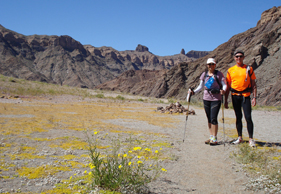Fish River Canyon Ultra, Namibia, August 2011
The race route differs slightly from the hiking trail in that the race starts from the main viewpoint, instead of Hobas, and with good reason. Days one and two of the hiking trail are rather gnarly and slow-going, with large boulders to negotiate. This is fine if you’re on a five-day hike, but would really put a damper on forward progression, speed and spirits in an ultra-distance, one-day run. Instead, the race route starts with a gentle 8km of dirt road, which serves as an ideal warm-up to prepare the legs for the descent into the canyon via the escape route above Sulphur (Palm) Springs.
FACING THE BOULDERS
This descent is not to be feared, as it is easier than it looks from the aid station on top. Once at the bottom, runners come face-to-face with their first boulder encounter. Crossing the many boulder fields throughout the canyon takes concentration, balance and agility if you hope to progress quickly and efficiently. It’s tough on the feet and ankles, and trekking poles do assist with stability as you run-hop-step from one boulder to the next. Between the boulder fields are stretches of firm trail and soft sand.
There are 20 river crossing. Yes, you heard right: 20. The Fish River meanders through the canyon, lazily snaking towards Ais-Ais. Although it is mostly possible to stay on one side of the canyon, you wouldn’t want to, as cutting the corners is the shortest and most efficient route. The race route map accurately shows the best crossing points (before or on bends) and it is usually through boulder fields which spill across the river. At the time of running of this inaugural Fish River Canyon Ultra in late August 2011, the river carried more water than usual for that time of year, but even so, all but one river crossing could be made without getting your feet wet, provided you chose a good place to boulder-hop.
TAKING ON THE HEAT
The benefit of so many crossings is that you’re rarely far from the river and at each crossing you can splash water over your head and drink directly from the river. Two short-cuts, also used by the hikers, take you cross-country to skip large bends. It’s on these sections where you really need to be carrying enough water.
Even at the tail-end of winter it was hot – really hot – in the canyon from 10:30am to 4pm. Good news is that the run will be held in June next year, when daytime temperatures range from 20 to 25?C. But even in winter it can reach 40?C at midday. As a result of extreme temperatures in the canyon, it is closed to hikers from mid-April to mid-September every year.
SETTING RECORDS
While the full hiking trail is listed as 86km, the new Ultra run is 65km. Namibian runner Frans Amunyela set the men’s record with his 9:36 winning time, while Lisa de Speville set the women’s time-to-beat of 11:39. With only two female runners at this inaugural event, de Speville had an easy day with no pressure. She’s convinced that she could take off an hour with little effort and that a faster female runner could drop this time even further, especially within a competitive field.
As a one-day trail ultra on a classic multi-day hiking trail, this Windhoek Fish River Canyon Ultra is, for sure, a scenic running experience. Put this one on your bucket list.
Plan Ahead for 2012
The date for the second running of this spectacular ultra has been set for 28 and 29 July 2012, timed to coincide with the full moon because many participants will run into the night.
Entry fee: The fee includes everything from the time you arrive in Windhoek (pre-canyon accommodation, and transport to and from the canyon) to your return to Windhoek after the race and is set at R6270 (incl VAT).
Getting there: There are two options if you’re travelling from South Africa: Fly into Windhoek and travel by official race vehicle to the Fish River Canyon, or fly into Upington, hire a car and drive to the Fish River Canyon. Ais-Ais does have a small landing strip, so it is also possible to charter a flight.
Staying there: The event organisation provides a tented camp (with mattresses and classy ablutions) perched on a spur overlooking the canyon for the pre-start night. In Windhoek, accommodation is arranged with the Klein Windhoek Guest House as part of the race package, and at the finish in Ais-Ais, the tented camp and an abundance of food and refreshments is most welcoming. It’s only a short walk from the tents to the swimming pool and hot springs. Breakfast at the hotel in the morning completes your post-race recharge.
For more details go to www.africanextremepromotions.com


